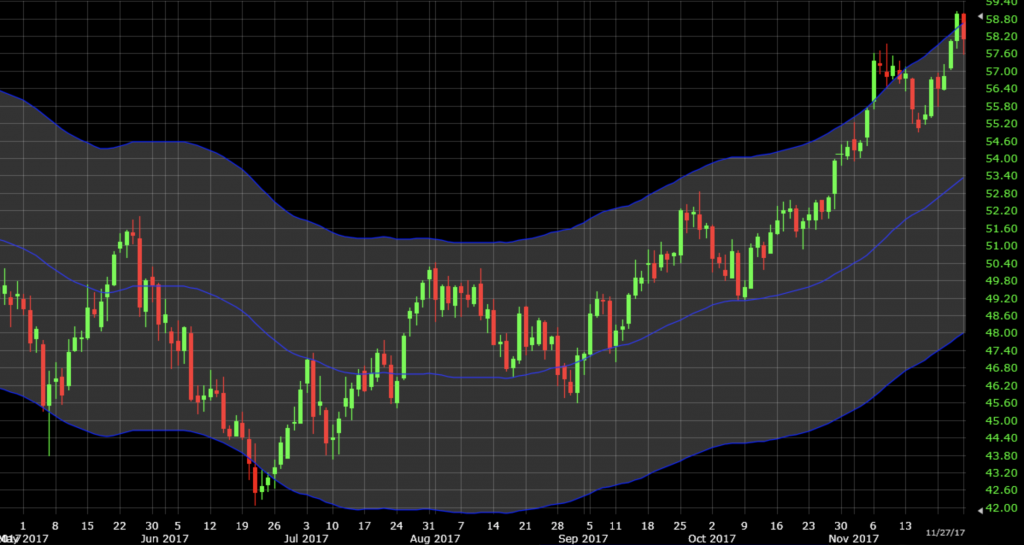Envelope Channel trading aik trading strategy hai jo price movements ko monitor karne ke liye use hoti hai. Is strategy mein, do moving averages ko plot kiya jata hai: aik upper envelope aur aik lower envelope. Yeh envelopes typically ek percentage distance par set kiye jate hain jo price ke upar aur neeche hotay hain. Jab price in envelopes ke andar rehti hai, to yeh indicate karta hai ke market stable hai. Aur jab price in envelopes ko cross karti hai, to yeh trading signals generate karta hai.
Buy Aur Sell Signals
Envelope Channel trading strategy mein, jab price lower envelope ko touch ya cross karti hai, to yeh aik buying signal hota hai. Yeh indicate karta hai ke price oversold hai aur wapas upar ja sakti hai. Is signal pe, traders assets khareedna shuru kar dete hain.

Wahi, jab price upper envelope ko touch ya cross karti hai, to yeh aik selling signal hota hai. Yeh indicate karta hai ke price overbought hai aur neeche gir sakti hai. Is signal pe, traders assets bechna shuru kar dete hain.
Market Conditions Aur Adjustments
Envelope Channel trading strategy har market condition mein kaam nahi karti. Yeh strategy trending markets mein zyada effective hoti hai jahan price ek consistent direction mein move kar rahi hoti hai. Agar market range-bound ho jahan price confined ho ek specific range mein, to false signals generate ho sakte hain. Isi liye, traders ko apni strategy ko adjust karna padta hai. Percentage distance ko envelopes ke liye adjust karna ek important factor hai. Volatile markets mein, wider envelopes use karne chahiye aur stable markets mein, narrow envelopes use kiye ja sakte hain.
Risk Management Aur Judgements
Risk management Envelope Channel trading mein bohot important hai. Har trade ke saath, stop-loss orders ko define karna chahiye taake potential losses ko minimize kiya ja sake. Yeh orders ensure karte hain ke agar market unexpectedly move kare, to losses control mein rahein. Saath hi, traders ko apni trading decisions ko based on reliable data aur analysis lena chahiye. Ismein historical price movements, current market trends aur other technical indicators ka analysis shamil hai. Yeh sab traders ko informed decisions lene mein madad dete hain aur successful trading judgements ko enhance Kia ja sakay.
Buy Aur Sell Signals
Envelope Channel trading strategy mein, jab price lower envelope ko touch ya cross karti hai, to yeh aik buying signal hota hai. Yeh indicate karta hai ke price oversold hai aur wapas upar ja sakti hai. Is signal pe, traders assets khareedna shuru kar dete hain.
Wahi, jab price upper envelope ko touch ya cross karti hai, to yeh aik selling signal hota hai. Yeh indicate karta hai ke price overbought hai aur neeche gir sakti hai. Is signal pe, traders assets bechna shuru kar dete hain.
Market Conditions Aur Adjustments
Envelope Channel trading strategy har market condition mein kaam nahi karti. Yeh strategy trending markets mein zyada effective hoti hai jahan price ek consistent direction mein move kar rahi hoti hai. Agar market range-bound ho jahan price confined ho ek specific range mein, to false signals generate ho sakte hain. Isi liye, traders ko apni strategy ko adjust karna padta hai. Percentage distance ko envelopes ke liye adjust karna ek important factor hai. Volatile markets mein, wider envelopes use karne chahiye aur stable markets mein, narrow envelopes use kiye ja sakte hain.
Risk Management Aur Judgements
Risk management Envelope Channel trading mein bohot important hai. Har trade ke saath, stop-loss orders ko define karna chahiye taake potential losses ko minimize kiya ja sake. Yeh orders ensure karte hain ke agar market unexpectedly move kare, to losses control mein rahein. Saath hi, traders ko apni trading decisions ko based on reliable data aur analysis lena chahiye. Ismein historical price movements, current market trends aur other technical indicators ka analysis shamil hai. Yeh sab traders ko informed decisions lene mein madad dete hain aur successful trading judgements ko enhance Kia ja sakay.




تبصرہ
Расширенный режим Обычный режим